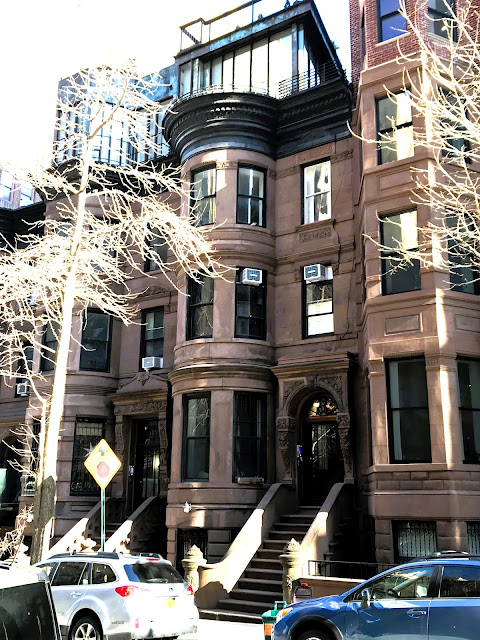Around 1888, Daniel Hallecy and John J. Egan, established the Egan & Hallecy Construction Company. They quickly became a force in Manhattan development, erecting scores of rowhouses. In 1891 they began construction of five upscale homes at 315 to 323 West 103rd Street designed by Martin V. B. Ferdon. Completed the following year, each of the brownstone faced, three-story-and-basement homes had cost $16,000 to erect, or about $553,000 in 2025 terms.
The residences were designed in the Renaissance Revival style. At 317 West 103rd Street, the wing-walled stoop spilled down to beefy stone newels, each girded with foliate carvings with a face in profile. The double-doored entrance featured an elegant fan light and sat within an elaborate framework. Caryatid-like brackets supported fruit-carved capitals. The arch included a fearsome portrait keystone and foliate spandrels. A full-height, rounded bay rose tower-like to the denticulated cornice.
The house was purchased by Richard Albert and Helena Waples Babbage. The couple had two children, Helena Maude and Richard. Their residency would be relatively short-lived. On March 4, 1895, an advertisement in the New York Press read:
317 West 103d St.--A superior 3 story and basement brownstone house, 20x55, with an extension, on the upper side of the street, and commanding charming views of the beautiful Riverside Drive and the Hudson; it is near the palatial residences on the drive and is in all respects desirable.
The Babbages sold the house to Eva P. and Abraham M. Graff on September 20, 1895, sparking a rapid-fire turnover of the property. Three days later, the Graffs sold 317 West 103rd Street to George E. and Florence E. S. Weyl. They remained just over two years, advertising it in January 1899 as being "in one of the choicest blocks up town."
It was next home to educator and author James E. Russell, dean of Teachers' College at Columbia University. Born in Hamden, New York, he graduated from Cornell University and did post-graduate studies in Jena, Berlin and Leipsic.
Journal of Education February 27, 1902 (copyright expired)
Strobel & Wilken Co. had greatly diversified since its inception. In 1878 it advertised, "importers and wholesale dealers in Fancy goods, Druggist, Sundries, Smokers' articles & Toys." But by the turn of the century, it was mostly known for its German-made bisque dolls marked with the initials SWC.
While Walter managed the business, his wife busied herself with more social pursuits. On March 10, 1907, for instance, The New York Times reported, "A pretty bridge party was that given recently by Mrs. Walter E. Strobel in her home, 317 West 103d Street."
Upon the death of Emil Strobel in 1916, Walter became vice-president. He briefly was president, and then in February 1926 was elected as a member of the board.
Walter retired in 1936. By then, the couple spent their summer months in Tarrytown, New York, where they were visible members of summer society. The Daily News of Tarrytown, for instance, reported on June 29, 1938, "Today, Mrs. Walter E. Strobel of New York City is entertaining at the club at a lunch for 20 guests." "The club" mentioned in the article was the Sleepy Hollow Country Club.
It is unclear when the Strobels left 317 West 103rd Street. It was converted to apartments, two per floor, in 1960. Among the tenants that year was Krythia Helen Reid. She was a documents assistant within the New Zealand Mission to the United Nations.
A rooftop addition was added to the Strobel house around the turn of the 21st century.
photographs by the author





.png)

Such a grand entrance.
ReplyDelete